Module 2 Unit 5 Magazine articles (Grammar I)
文档属性
| 名称 | Module 2 Unit 5 Magazine articles (Grammar I) |  | |
| 格式 | zip | ||
| 文件大小 | 15.9MB | ||
| 资源类型 | 教案 | ||
| 版本资源 | 牛津上海版(试用本) | ||
| 科目 | 英语 | ||
| 更新时间 | 2013-03-05 18:40:12 | ||
图片预览

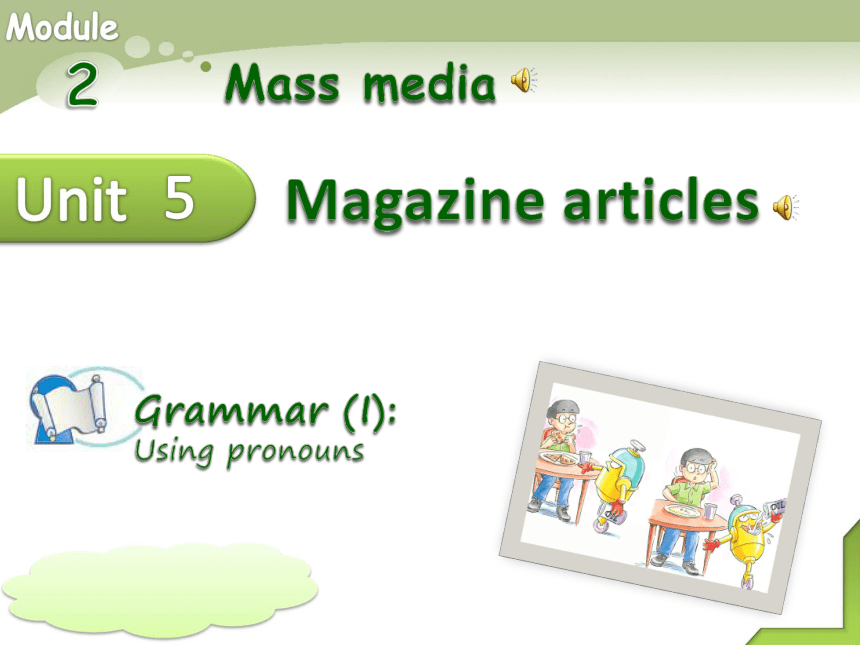



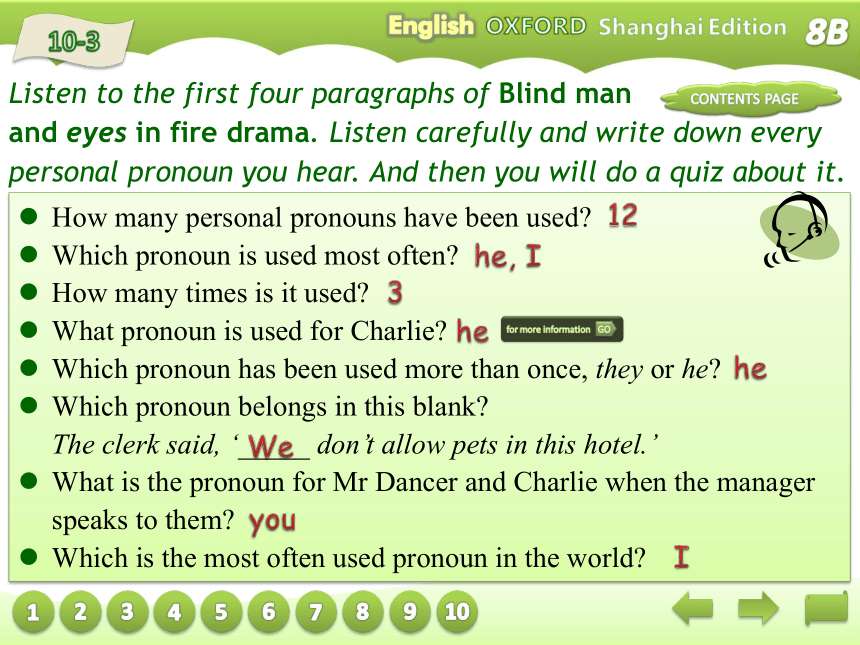
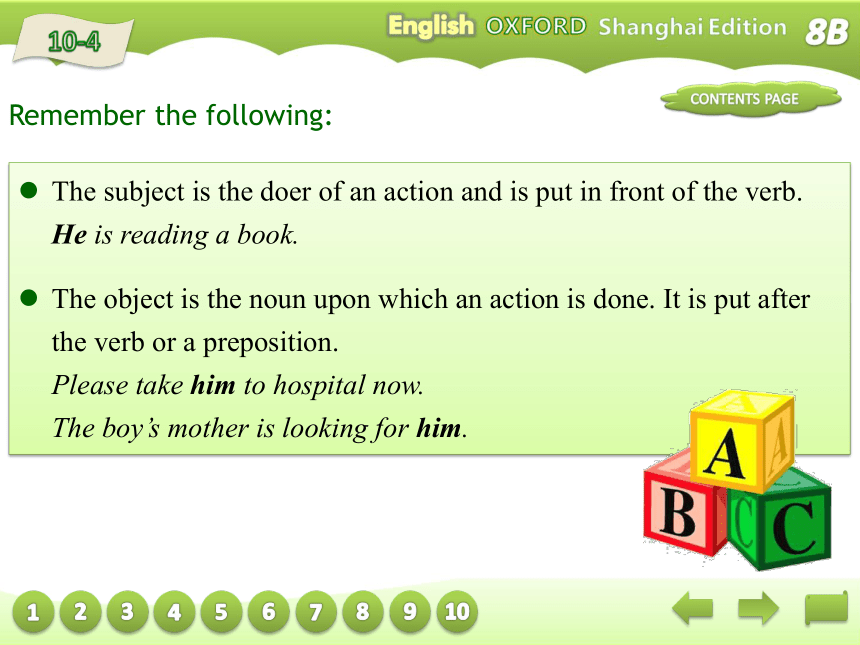

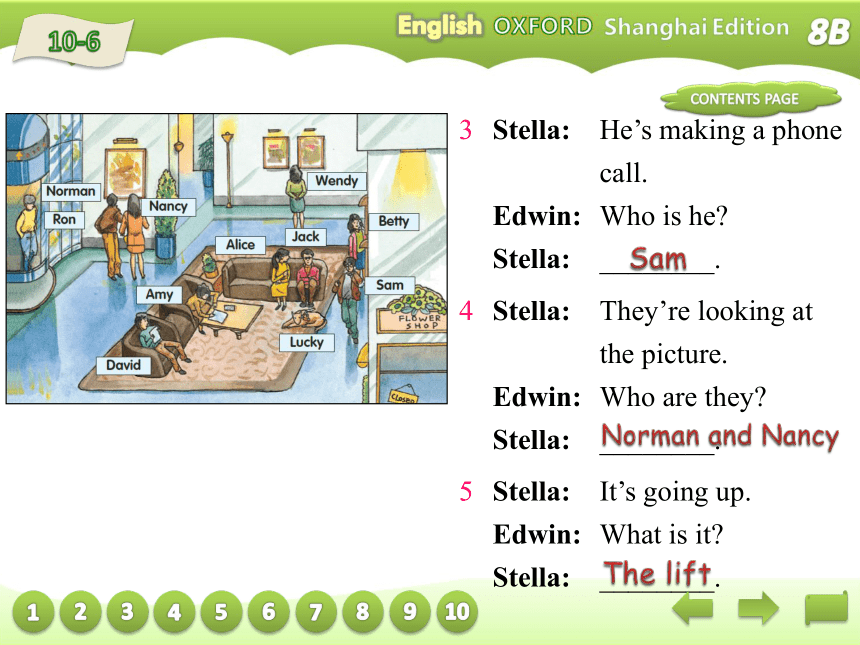
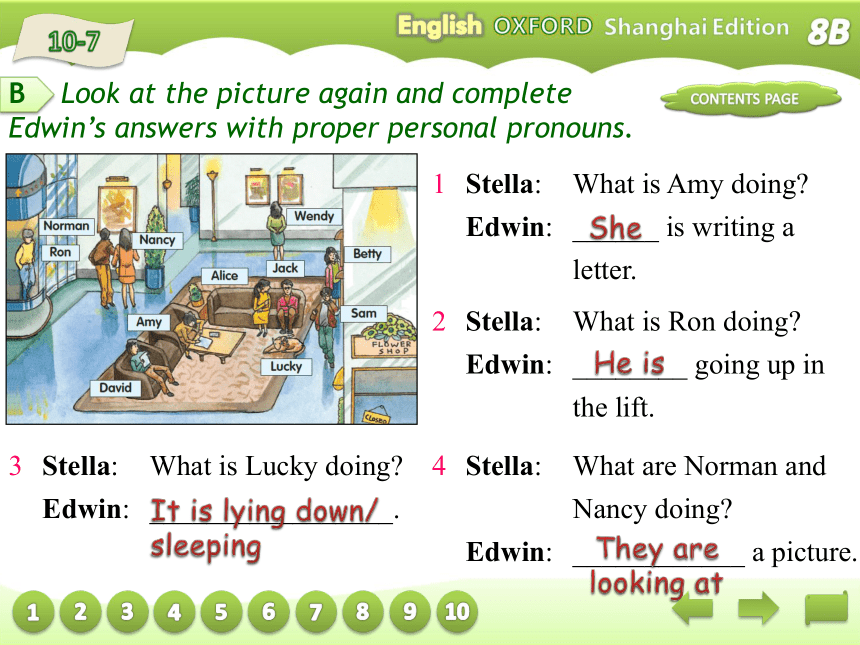
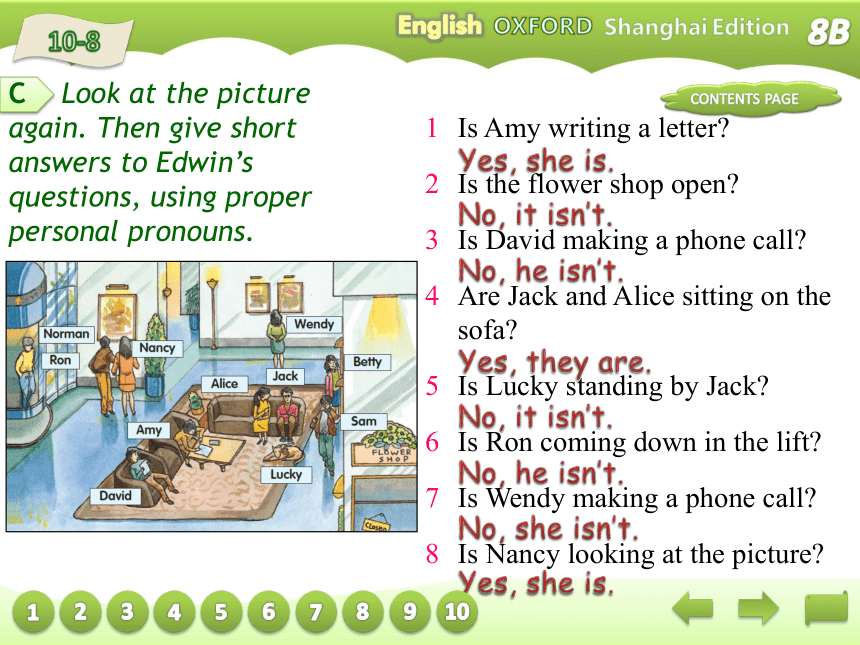

文档简介
课件32张PPT。2Mass mediaMagazine articlesGrammar (I):
Using pronouns5CONTENTS PAGEReflexive pronounsPersonal pronounsPossessive adjectivesPersonal pronouns10-1123We use personal pronouns so that we do not need to repeat certain words all the time.
Here is an example. We do not want to repeat the manager all the time, so we use she.
The manager came. The manager said, ‘You are both welcome, sir.’
The manager came. She said, ‘You are both welcome, sir.’4567891010-2123Remember the following:45678910Listen to the first four paragraphs of Blind man and eyes in fire drama. Listen carefully and write down every personal pronoun you hear. And then you will do a quiz about it.How many personal pronouns have been used?
Which pronoun is used most often?
How many times is it used?
What pronoun is used for Charlie?
Which pronoun has been used more than once, they or he?
Which pronoun belongs in this blank? The clerk said, ‘_____ don’t allow pets in this hotel.’
What is the pronoun for Mr Dancer and Charlie when the manager speaks to them?
Which is the most often used pronoun in the world?12he, I3heheWeyouI10-31234567891010-4123Remember the following:The subject is the doer of an action and is put in front of the verb. He is reading a book.
The object is the noun upon which an action is done. It is put after the verb or a preposition. Please take him to hospital now. The boy’s mother is looking for him.45678910A Look at the picture below and answer Edwin’s questions by giving the correct names.AmyJack10-512345678910SamNorman and NancyThe lift10-612345678910B Look at the picture again and complete Edwin’s answers with proper personal pronouns.SheHe isIt is lying down/ sleepingThey are looking at10-712345678910Is Amy writing a letter?
Is the flower shop open?
Is David making a phone call?
Are Jack and Alice sitting on the sofa?
Is Lucky standing by Jack?
Is Ron coming down in the lift?
Is Wendy making a phone call?
Is Nancy looking at the picture?C Look at the picture again. Then give short answers to Edwin’s questions, using proper personal pronouns.Yes, she is.No, it isn’t.No, he isn’t.Yes, they are.No, it isn’t.No, he isn’t.No, she isn’t.Yes, she is.10-812345678910D Use the words in the box on the right to complete the following dialogues.1 Mary: What’s the postman giving Mrs Xu?
Alice: _____________________ a letter.
2 Mary: What is Mrs Huang telling Ben?
Alice: _____________________ the time.
3 Mary: Where is Mrs Chen taking John and Amy?
Alice: _____________________ across the busy road.
4 Mary: What is the policeman showing Helen?
Alice: _____________________ the way to the bus station.
5 Mary: Where are Kevin and Joan putting the box?
Alice: _____________________ on the car.He is giving herShe is telling himShe is taking themHe is showing herThey are putting itthey
them
him
she
her
he
it10-912345678910*E Look at the picture. Work in pairs. Ask about what the people in the picture doing and give proper answers using proper personal pronouns.10-1012345678910Possessive adjectives7-112We use possessive adjectives with nouns. Then we don’t need to repeat names all the time. Here is an example:John’s troubles began as soon as John walked into the hotel with John’s friend Charlie.
John’s troubles began as soon as he walked into the hotel with his friend Charlie.Remember the following:34567A The people in the pictures are telling us about themselves. Complete their words.7-212345671Hello, everyone! ______ name is Millie. ______ am from Hong Kong. ______ am going to tell some jokes. Listen to ______ carefully.MyIIme7-31234567Hello, everyone! ______ names are Cindy and Sandy. ______ are from Shanghai. ______ are going to do some magic tricks. Watch ______ carefully.2Hello, everyone! ______ names are Cindy and Sandy. ______ are from Shanghai. ______ are going to do some magic tricks. Watch ______ carefully.OurWeWeus7-41234567B Edwin used pronouns in the following story, but he did not use enough. Read the story and change the italicized words into pronouns.7-5Nothing
Ms Connor, a teacher in Canada, once asked her students to write a composition. ‘(1) The composition’s title is “What I did during my holidays”,’ (2) the teacher said.
One student stood up. (3) The student’s name was Tom. (4) Tom asked, ‘How long must the composition be?’ItssheHisHe12345677-6‘(5) The composition can be any length,’ said the teacher. She added that (6) the composition had to describe exactly what the students did during (7) the students’ holidays. She told (8) the students that she would collect the compositions from (9) the students the next day.Itittheirthemthem12345677-7The next day, the students gave (10) the teacher (11) the students’ compositions. (12) The teacher looked at (13) the compositions and then looked at Tom. (14) The teacher asked (15) Tom to stand up.
‘What’s this, Tom?’ (16) the teacher said. ‘You’ve written nothing on your paper.’
‘That’s right, Miss,’ said Tom. ‘That’s exactly what I did during my holidays.’hertheirShethemShehimShe1234567Reflexive pronouns10-1123We form reflexive pronouns with self or selves.For 1st and 2nd persons: possessive adjective + self/selvesmy + self ? myselfour + selves ? ourselvesyour + self ? yourselfyour + selves ? yourselvesFor 3rd persons: object personal pronoun + self/selveshim + self ? himselfher + self ? herselfit + self ? itselfthem + selves ? themselves45678910We usually use a reflexive pronoun as an object to refer to the same thing as the subject. The old woman fell over and hurt herself.
We should be proud of ourselves. 10-2123We can also use a reflexive pronoun to emphasize a noun phrase, or to mean ‘without help’.I myself do not like the picture. (I don’t like it, but other people might.)
They wrote the report themselves. (They wrote it without any help.)45678910Sometimes we use a reflexive pronoun to make the meaning clear. She bought the flowers for herself. (not for someone else)
There are some idiomatic uses of a verb + reflexive pronoun. We all enjoyed ourselves at the party. (= had a good time) Ann, just help yourself. (= give yourself food, drinks, etc.)10-312345678910A Look at the pictures and complete the sentences with proper reflexive pronouns.1ourselvesthemselves10-4123456789102I can sweep the floor ____________. Alice can clean up the desks ____________.myselfherself10-5123456789103No. He can do it ____________.Shall we help Joe put the books on the shelves?himself10-612345678910B Look at the pictures and complete the conversations with reflexive pronouns.1Did you enjoy __________ at the party?
We certainly did!yourselves10-7123456789102What happened?
He was so careless that he hurt __________.himself10-8123456789103Do you need any help?
No, thanks. We can do it __________.ourselves10-9123456789104What is she doing?
She is looking at __________ in the mirror.herself10-1012345678910ConsolidationWorkbook 8B, pages 36, 37 and 38.
When an animal is personalized by giving it a human name or when we know for certain the sex of the animal, it usually takes the masculine and feminine pronouns he and she, not the neutral it (e.g., My dog Fred eats too much. He’s
fat.).
Using pronouns5CONTENTS PAGEReflexive pronounsPersonal pronounsPossessive adjectivesPersonal pronouns10-1123We use personal pronouns so that we do not need to repeat certain words all the time.
Here is an example. We do not want to repeat the manager all the time, so we use she.
The manager came. The manager said, ‘You are both welcome, sir.’
The manager came. She said, ‘You are both welcome, sir.’4567891010-2123Remember the following:45678910Listen to the first four paragraphs of Blind man and eyes in fire drama. Listen carefully and write down every personal pronoun you hear. And then you will do a quiz about it.How many personal pronouns have been used?
Which pronoun is used most often?
How many times is it used?
What pronoun is used for Charlie?
Which pronoun has been used more than once, they or he?
Which pronoun belongs in this blank? The clerk said, ‘_____ don’t allow pets in this hotel.’
What is the pronoun for Mr Dancer and Charlie when the manager speaks to them?
Which is the most often used pronoun in the world?12he, I3heheWeyouI10-31234567891010-4123Remember the following:The subject is the doer of an action and is put in front of the verb. He is reading a book.
The object is the noun upon which an action is done. It is put after the verb or a preposition. Please take him to hospital now. The boy’s mother is looking for him.45678910A Look at the picture below and answer Edwin’s questions by giving the correct names.AmyJack10-512345678910SamNorman and NancyThe lift10-612345678910B Look at the picture again and complete Edwin’s answers with proper personal pronouns.SheHe isIt is lying down/ sleepingThey are looking at10-712345678910Is Amy writing a letter?
Is the flower shop open?
Is David making a phone call?
Are Jack and Alice sitting on the sofa?
Is Lucky standing by Jack?
Is Ron coming down in the lift?
Is Wendy making a phone call?
Is Nancy looking at the picture?C Look at the picture again. Then give short answers to Edwin’s questions, using proper personal pronouns.Yes, she is.No, it isn’t.No, he isn’t.Yes, they are.No, it isn’t.No, he isn’t.No, she isn’t.Yes, she is.10-812345678910D Use the words in the box on the right to complete the following dialogues.1 Mary: What’s the postman giving Mrs Xu?
Alice: _____________________ a letter.
2 Mary: What is Mrs Huang telling Ben?
Alice: _____________________ the time.
3 Mary: Where is Mrs Chen taking John and Amy?
Alice: _____________________ across the busy road.
4 Mary: What is the policeman showing Helen?
Alice: _____________________ the way to the bus station.
5 Mary: Where are Kevin and Joan putting the box?
Alice: _____________________ on the car.He is giving herShe is telling himShe is taking themHe is showing herThey are putting itthey
them
him
she
her
he
it10-912345678910*E Look at the picture. Work in pairs. Ask about what the people in the picture doing and give proper answers using proper personal pronouns.10-1012345678910Possessive adjectives7-112We use possessive adjectives with nouns. Then we don’t need to repeat names all the time. Here is an example:John’s troubles began as soon as John walked into the hotel with John’s friend Charlie.
John’s troubles began as soon as he walked into the hotel with his friend Charlie.Remember the following:34567A The people in the pictures are telling us about themselves. Complete their words.7-212345671Hello, everyone! ______ name is Millie. ______ am from Hong Kong. ______ am going to tell some jokes. Listen to ______ carefully.MyIIme7-31234567Hello, everyone! ______ names are Cindy and Sandy. ______ are from Shanghai. ______ are going to do some magic tricks. Watch ______ carefully.2Hello, everyone! ______ names are Cindy and Sandy. ______ are from Shanghai. ______ are going to do some magic tricks. Watch ______ carefully.OurWeWeus7-41234567B Edwin used pronouns in the following story, but he did not use enough. Read the story and change the italicized words into pronouns.7-5Nothing
Ms Connor, a teacher in Canada, once asked her students to write a composition. ‘(1) The composition’s title is “What I did during my holidays”,’ (2) the teacher said.
One student stood up. (3) The student’s name was Tom. (4) Tom asked, ‘How long must the composition be?’ItssheHisHe12345677-6‘(5) The composition can be any length,’ said the teacher. She added that (6) the composition had to describe exactly what the students did during (7) the students’ holidays. She told (8) the students that she would collect the compositions from (9) the students the next day.Itittheirthemthem12345677-7The next day, the students gave (10) the teacher (11) the students’ compositions. (12) The teacher looked at (13) the compositions and then looked at Tom. (14) The teacher asked (15) Tom to stand up.
‘What’s this, Tom?’ (16) the teacher said. ‘You’ve written nothing on your paper.’
‘That’s right, Miss,’ said Tom. ‘That’s exactly what I did during my holidays.’hertheirShethemShehimShe1234567Reflexive pronouns10-1123We form reflexive pronouns with self or selves.For 1st and 2nd persons: possessive adjective + self/selvesmy + self ? myselfour + selves ? ourselvesyour + self ? yourselfyour + selves ? yourselvesFor 3rd persons: object personal pronoun + self/selveshim + self ? himselfher + self ? herselfit + self ? itselfthem + selves ? themselves45678910We usually use a reflexive pronoun as an object to refer to the same thing as the subject. The old woman fell over and hurt herself.
We should be proud of ourselves. 10-2123We can also use a reflexive pronoun to emphasize a noun phrase, or to mean ‘without help’.I myself do not like the picture. (I don’t like it, but other people might.)
They wrote the report themselves. (They wrote it without any help.)45678910Sometimes we use a reflexive pronoun to make the meaning clear. She bought the flowers for herself. (not for someone else)
There are some idiomatic uses of a verb + reflexive pronoun. We all enjoyed ourselves at the party. (= had a good time) Ann, just help yourself. (= give yourself food, drinks, etc.)10-312345678910A Look at the pictures and complete the sentences with proper reflexive pronouns.1ourselvesthemselves10-4123456789102I can sweep the floor ____________. Alice can clean up the desks ____________.myselfherself10-5123456789103No. He can do it ____________.Shall we help Joe put the books on the shelves?himself10-612345678910B Look at the pictures and complete the conversations with reflexive pronouns.1Did you enjoy __________ at the party?
We certainly did!yourselves10-7123456789102What happened?
He was so careless that he hurt __________.himself10-8123456789103Do you need any help?
No, thanks. We can do it __________.ourselves10-9123456789104What is she doing?
She is looking at __________ in the mirror.herself10-1012345678910ConsolidationWorkbook 8B, pages 36, 37 and 38.
When an animal is personalized by giving it a human name or when we know for certain the sex of the animal, it usually takes the masculine and feminine pronouns he and she, not the neutral it (e.g., My dog Fred eats too much. He’s
fat.).
